Artificial Intelligence-Driven Multi-Energy Optimization: Promoting Green Transition of Rural Energy Planning and Sustainable Energy Economy
Abstract
1. Introduction
2. Literature Review
3. Research Methodology
3.1. Energy System Supply Patterns in Rural Areas of China
3.2. Energy System Planning Models with the Coupling of Different Energy Sources
3.3. Optimization of Energy Systems Based on AI-Driven Planning and Operation
3.4. Experimental Data
4. Experimental Design and Performance Evaluation
4.1. Scenario Case Analysis Experiment
4.2. Prediction Results of Grid Transformation Project
- X County:
- 2.
- Y County:
- 3.
- Z County:
4.3. Explanation of Model Results and Policy Relevance
4.4. Strategies to Stabilize Housing Prices for Particle Matter and Air Pollution
4.5. Potential and Challenges of Solar Photovoltaic and Wind Power Generation Projects
5. Conclusions
Author Contributions
Funding
Institutional Review Board Statement
Informed Consent Statement
Data Availability Statement
Conflicts of Interest
References
- Chen, C.; Hu, Y.; Karuppiah, M.; Kumar, P.M. Artificial intelligence on economic evaluation of energy efficiency and renewable energy technologies. Sustain. Energy Technol. Assess. 2021, 47, 101358. [Google Scholar] [CrossRef]
- Abdalla, A.N.; Nazir, M.S.; Tao, H.; Cao, S.; Ji, R.; Jiang, M.; Yao, L. Integration of energy storage system and renewable energy sources based on artificial intelligence: An overview. J. Energy Storage 2021, 40, 102811. [Google Scholar] [CrossRef]
- Ahmad, T.; Madonski, R.; Zhang, D.; Huang, C.; Mujeeb, A. Data-driven probabilistic machine learning in sustainable smart energy/smart energy systems: Key developments, challenges, and future research opportunities in the context of smart grid paradigm. Renew. Sustain. Energy Rev. 2022, 160, 112128. [Google Scholar] [CrossRef]
- Şerban, A.C.; Lytras, M.D. Artificial intelligence for smart renewable energy sector in Europe—Smart energy infrastructures for next generation smart cities. IEEE Access 2020, 8, 77364–77377. [Google Scholar] [CrossRef]
- Leal Filho, W.; Viera Trevisan, L.; Simon Rampasso, I.; Anholon, R.; Pimenta Dinis, M.A.; Londero Brandli, L.; Sierra, J.; Lange Salvia, A.; Pretorius, R.; Nicolau, M.; et al. When the alarm bells ring: Why the UN sustainable development goals may not be achieved by 2030. J. Clean. Prod. 2023, 407, 137108. [Google Scholar] [CrossRef]
- Zou, C.; Ma, F.; Pan, S.; Zhao, Q.; Fu, G.; Zhang, G.; Yang, Y.; Yu, H.; Liang, Y.; Lin, M.; et al. Global energy transition revolution and the connotation and pathway of the green and intelligent energy system. Pet. Explor. Dev. 2023, 50, 722–740. [Google Scholar] [CrossRef]
- Miskat, M.I.; Sarker, P.; Chowdhury, H.; Chowdhury, T.; Rahman, M.S.; Hossain, N.; Chowdhury, P.; Sait, S.M. Current Scenario of Solar Energy Applications in Bangladesh: Techno-Economic Perspective, Policy Implementation, and Possibility of the Integration of Artificial Intelligence. Energies 2023, 16, 1494. [Google Scholar] [CrossRef]
- Nam, K.; Hwangbo, S.; Yoo, C. A deep learning-based forecasting model for renewable energy scenarios to guide sustainable energy policy: A case study of Korea. Renew. Sustain. Energy Rev. 2020, 122, 109725. [Google Scholar] [CrossRef]
- Yigitcanlar, T.; Mehmood, R.; Corchado, J.M. Green artificial intelligence: Towards an efficient, sustainable and equitable technology for smart cities and futures. Sustainability 2021, 13, 8952. [Google Scholar] [CrossRef]
- Yildizbasi, A. Blockchain and renewable energy: Integration challenges in circular economy era. Renew. Energy 2021, 176, 183–197. [Google Scholar] [CrossRef]
- Agostinelli, S.; Cumo, F.; Guidi, G.; Tomazzoli, C. Cyber-Physical systems improving building energy management: Digital twin and artificial intelligence. Energies 2021, 14, 2338. [Google Scholar] [CrossRef]
- Dogaru, L. The main goals of the fourth industrial revolution. Renewable energy perspectives. Procedia Manuf. 2020, 46, 397–401. [Google Scholar] [CrossRef]
- Al-Othman, A.; Tawalbeh, M.; Martis, R.; Dhou, S.; Orhan, M.; Qasim, M.; Ghani Olabi, A. Artificial intelligence and numerical models in hybrid renewable energy systems with fuel cells: Advances and prospects. Energy Convers. Manag. 2022, 253, 115154. [Google Scholar] [CrossRef]
- Palomares, I.; Martínez-Cámara, E.; Montes, R.; García-Moral, P.; Chiachio, M.; Chiachio, J.; Alonso, S.; Melero, F.J.; Molina, D.; Fernández, B.; et al. A panoramic view and swot analysis of artificial intelligence for achieving the sustainable development goals by 2030: Progress and prospects. Appl. Intell. 2021, 51, 6497–6527. [Google Scholar] [CrossRef] [PubMed]
- Liu, X.; Zhao, T.; Chang, C.-T.; Fu, C.J. China’s renewable energy strategy and industrial adjustment policy. Renew. Energy 2021, 170, 1382–1395. [Google Scholar] [CrossRef]
- Tutak, M.; Brodny, J.; Siwiec, D.; Ulewicz, R.; Bindzár, P. Studying the level of sustainable energy development of the European union countries and their similarity based on the economic and demographic potential. Energies 2020, 13, 6643. [Google Scholar] [CrossRef]
- Nishant, R.; Kennedy, M.; Corbett, J. Artificial intelligence for sustainability: Challenges, opportunities, and a research agenda. Int. J. Inf. Manag. 2020, 53, 102104. [Google Scholar] [CrossRef]
- Vanegas Cantarero, M.M. Of renewable energy, energy democracy, and sustainable development: A roadmap to accelerate the energy transition in developing countries. Energy Res. Soc. Sci. 2020, 70, 101716. [Google Scholar] [CrossRef]
- Wang, Z.; Zhang, S.; Zhao, Y.; Chen, C.; Dong, X. Risk prediction and credibility detection of network public opinion using blockchain technology. Technol. Forecast. Soc. Change 2023, 187, 122177. [Google Scholar] [CrossRef]
- Deng, Y.; Jiang, W.; Wang, Z. Economic resilience assessment and policy interaction of coal resource oriented cities for the low carbon economy based on AI. Resour. Policy 2023, 82, 103522. [Google Scholar] [CrossRef]
- Li, C.; Liang, F.; Liang, Y.; Wang, Z. Low-carbon strategy, entrepreneurial activity, and industrial structure change: Evidence from a quasi-natural experiment. J. Clean. Prod. 2023, 427, 139183. [Google Scholar] [CrossRef]
- Li, D.D.; Guan, X.; Tang, T.T.; Zhao, L.Y.; Tong, W.R.; Wang, Z.Y. The clean energy development path and sustainable development of the ecological environment driven by big data for mining projects. J. Environ. Manag. 2023, 348, 119426. [Google Scholar] [CrossRef] [PubMed]
- Li, C.; Tang, W.; Liang, F.; Wang, Z. The impact of climate change on corporate ESG performance: The role of resource misallocation in enterprises. J. Clean. Prod. 2024, 445, 141263. [Google Scholar] [CrossRef]
- Wang, Z.; Guan, X.; Zeng, Y.; Liang, X.; Dong, S. Utilizing data platform management to implement “5W” analysis framework for preventing and controlling corruption in grassroots government. Heliyon 2024, 10, e28601. [Google Scholar] [CrossRef] [PubMed]
- Li, Y.; Zhang, Y.; Hu, J.; Wang, Z. Insight into the nexus between intellectual property pledge financing and enterprise innovation: A systematic analysis with multidimensional perspectives. Int. Rev. Econ. Financ. 2024, 93, 700–719. [Google Scholar] [CrossRef]
- Liu, T.; Guan, X.; Wang, Z.; Qin, T.; Sun, R.; Wang, Y. Optimizing green supply chain circular economy in smart cities with integrated machine learning technology. Heliyon 2024, 10, e29825. [Google Scholar] [CrossRef]
- Ghadami, N.; Gheibi, M.; Kian, Z.; Faramarz, M.G.; Naghedi, R.; Eftekhari, M.; Fathollahi-Fard, A.M.; Dulebenets, M.A.; Tian, G. Implementation of solar energy in smart cities using an integration of artificial neural network, photovoltaic system and classical Delphi methods. Sustain. Cities Soc. 2021, 74, 103149. [Google Scholar] [CrossRef]
- Østergaard, P.A.; Duic, N.; Noorollahi, Y.; Mikulcic, H.; Kalogirou, S. Sustainable development using renewable energy technology. Renew. Energy 2020, 146, 2430–2437. [Google Scholar] [CrossRef]
- Shahbaz, M.; Wang, J.; Dong, K.; Zhao, J. The impact of digital economy on energy transition across the globe: The mediating role of government governance. Renew. Sustain. Energy Rev. 2022, 166, 112620. [Google Scholar] [CrossRef]
- Yigitcanlar, T.; Desouza, K.C.; Butler, L.; Roozkhosh, F. Contributions and risks of artificial intelligence (AI) in building smarter cities: Insights from a systematic review of the literature. Energies 2020, 13, 1473. [Google Scholar] [CrossRef]
- Di Vaio, A.; Palladino, R.; Hassan, R.; Escobar, O. Artificial intelligence and business models in the sustainable development goals perspective: A systematic literature review. J. Bus. Res. 2020, 121, 283–314. [Google Scholar] [CrossRef]
- Xiang, X.; Li, Q.; Khan, S.; Khalaf, O.I. Urban water resource management for sustainable environment planning using artificial intelligence techniques. Environ. Impact Assess. Rev. 2021, 86, 106515. [Google Scholar] [CrossRef]
- Xu, X.; Wei, Z.; Ji, Q.; Wang, C.; Gao, G. Global renewable energy development: Influencing factors, trend predictions and countermeasures. Resour. Policy 2019, 63, 101470. [Google Scholar] [CrossRef]
- Awan, A.; Abbasi, K.R.; Rej, S.; Bandyopadhyay, A.; Lv, K. The impact of renewable energy, internet use and foreign direct investment on carbon dioxide emissions: A method of moments quantile analysis. Renew. Energy 2022, 189, 454–466. [Google Scholar] [CrossRef]
- Mhlanga, D. Artificial intelligence in the industry 4.0, and its impact on poverty, innovation, infrastructure development, and the sustainable development goals: Lessons from emerging economies? Sustainability 2021, 13, 5788. [Google Scholar] [CrossRef]
- Zhong, Z.; Peng, B.; Xu, L.; Andrews, A.; Elahi, E. Analysis of regional energy economic efficiency and its influencing factors: A case study of Yangtze river urban agglomeration. Sustain. Energy Technol. Assess. 2020, 41, 100784. [Google Scholar] [CrossRef]
- López González, D.M.; Garcia Rendon, J. Opportunities and challenges of mainstreaming distributed energy resources towards the transition to more efficient and resilient energy markets. Renew. Sustain. Energy Rev. 2022, 157, 112018. [Google Scholar] [CrossRef]
- He, Z.; Guo, W.; Zhang, P. Performance prediction, optimal design and operational control of thermal energy storage using artificial intelligence methods. Renew. Sustain. Energy Rev. 2022, 156, 111977. [Google Scholar] [CrossRef]
- Inderwildi, O.; Zhang, C.; Wang, X.; Kraft, M. The impact of intelligent cyber-physical systems on the decarbonization of energy. Energy Environ. Sci. 2020, 13, 744–771. [Google Scholar] [CrossRef]
- Sachs, J.D.; Schmidt-Traub, G.; Mazzucato, M.; Messner, D.; Nakicenovic, N.; Rockström, J. Six transformations to achieve the sustainable development goals. Nat. Sustain. 2019, 2, 805–814. [Google Scholar] [CrossRef]
- Wu, J.; Zhang, J.; Tan, W.; Lan, H.; Zhang, S.; Xiao, K.; Wang, L.; Lin, H.; Sun, G.; Guo, P. Application of Time Serial Model in Water Quality Predicting. Comput. Mater. Contin. 2023, 74, 67–82. [Google Scholar] [CrossRef]
- Yang, X.; Ran, G. Forecasting China’s CO2 emissions and identifying key drivers: An application of the improved RFAGM model and LMDI decomposition methods. Int. J. Sustain. Dev. World Ecol. 2024, 1–14. [Google Scholar] [CrossRef]
- Babatunde, D.E.; Anozie, A.N.; Omoleye, J.A. Artificial neural network and its applications in the energy sector—An overview. Int. J. Energy Econ. Policy 2020, 10, 250–264. [Google Scholar] [CrossRef]
- Bashir, M.F.; Ma, B.; Hussain, H.I.; Shahbaz, M.; Koca, K.; Shahzadi, I. Evaluating environmental commitments to COP21 and the role of economic complexity, renewable energy, financial development, urbanization, and energy innovation: Empirical evidence from the RCEP countries. Renew. Energy 2022, 184, 541–550. [Google Scholar] [CrossRef]
- Leal Filho, W.; Yang, P.; Eustachio, J.H.P.P.; Azul, A.M.; Gellers, J.C.; Gielczyk, A.; Dinis, M.A.P.; Kozlova, V. Deploying digitalisation and artificial intelligence in sustainable development research. Environ. Dev. Sustain. 2023, 25, 4957–4988. [Google Scholar] [CrossRef]
- Mohammadi, E.; Alizadeh, M.; Asgarimoghaddam, M.; Wang, X.; Simões, M.G. A review on application of artificial intelligence techniques in microgrids. IEEE J. Emerg. Sel. Top. Ind. Electron. 2022, 3, 878–890. [Google Scholar] [CrossRef]
- Yigitcanlar, T.; Cugurullo, F. The sustainability of artificial intelligence: An urbanistic viewpoint from the lens of smart and sustainable cities. Sustainability 2020, 12, 8548. [Google Scholar] [CrossRef]
- Niazkar, M.; Goodarzi, M.R.; Fatehifar, A.; Abedi, M.J. Machine learning-based downscaling: Application of multi-gene genetic programming for downscaling daily temperature at Dogonbadan, Iran, under CMIP6 scenarios. Theor. Appl. Climatol. 2023, 151, 153–168. [Google Scholar] [CrossRef]
- Marzban, N.; Libra, J.A.; Hosseini, S.H.; Fischer, M.G.; Rotter, V.S. Experimental evaluation and application of genetic programming to develop predictive correlations for hydrochar higher heating value and yield to optimize the energy content. J. Environ. Chem. Eng. 2022, 10, 108880. [Google Scholar] [CrossRef]

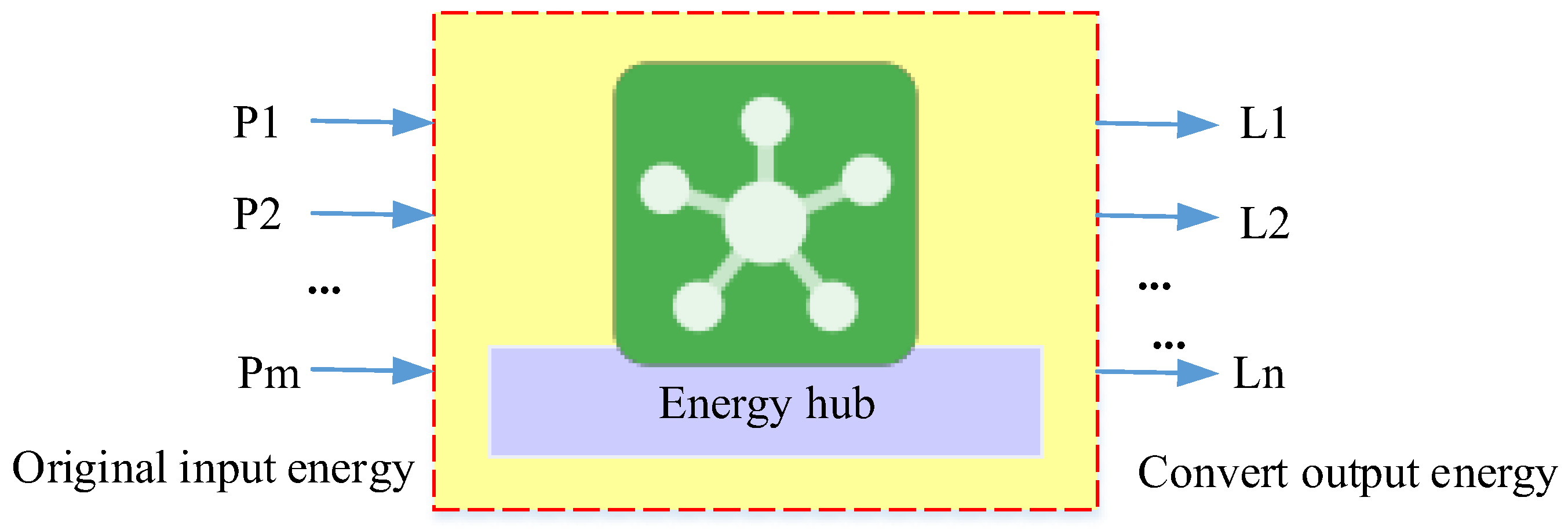
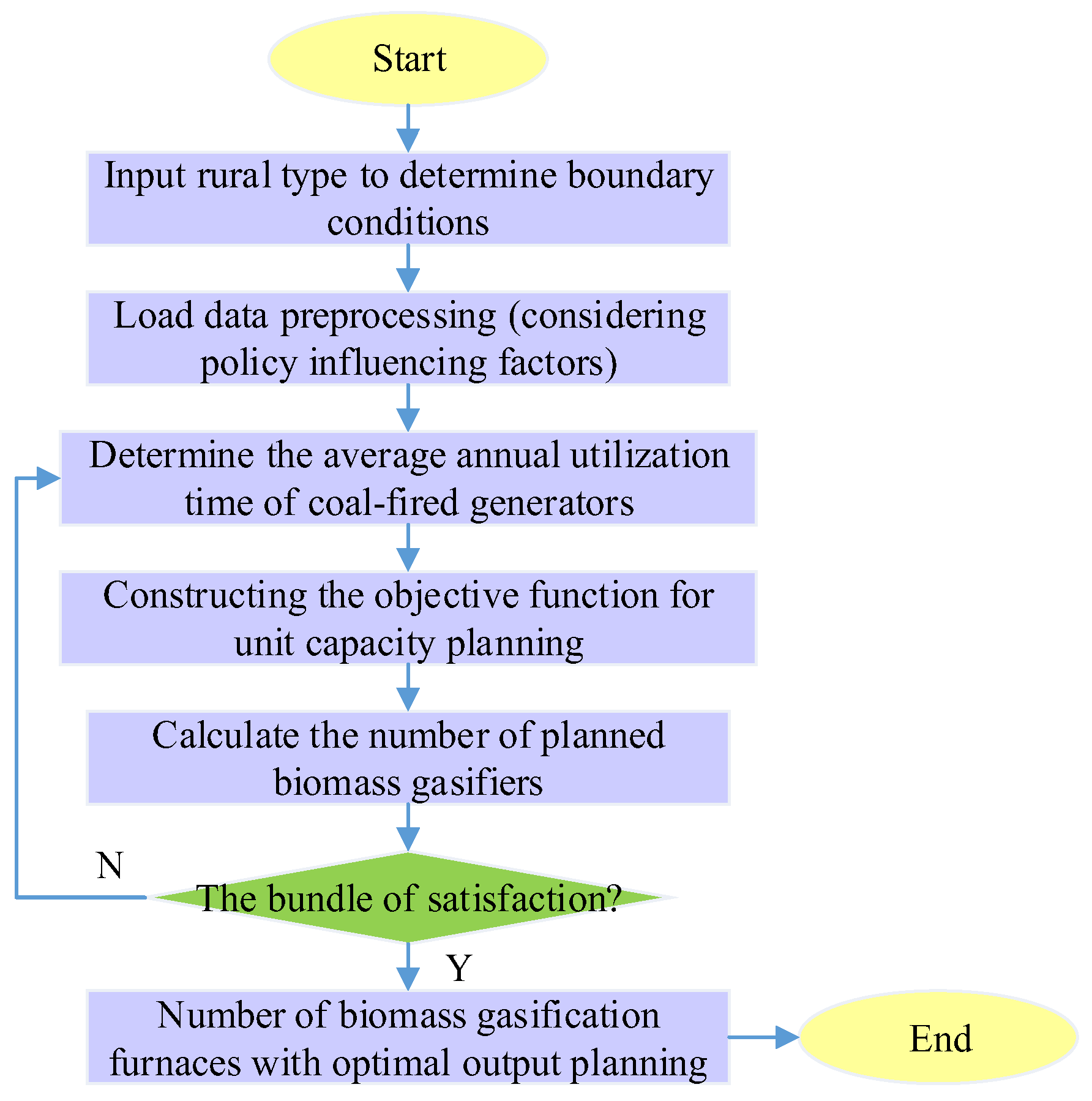
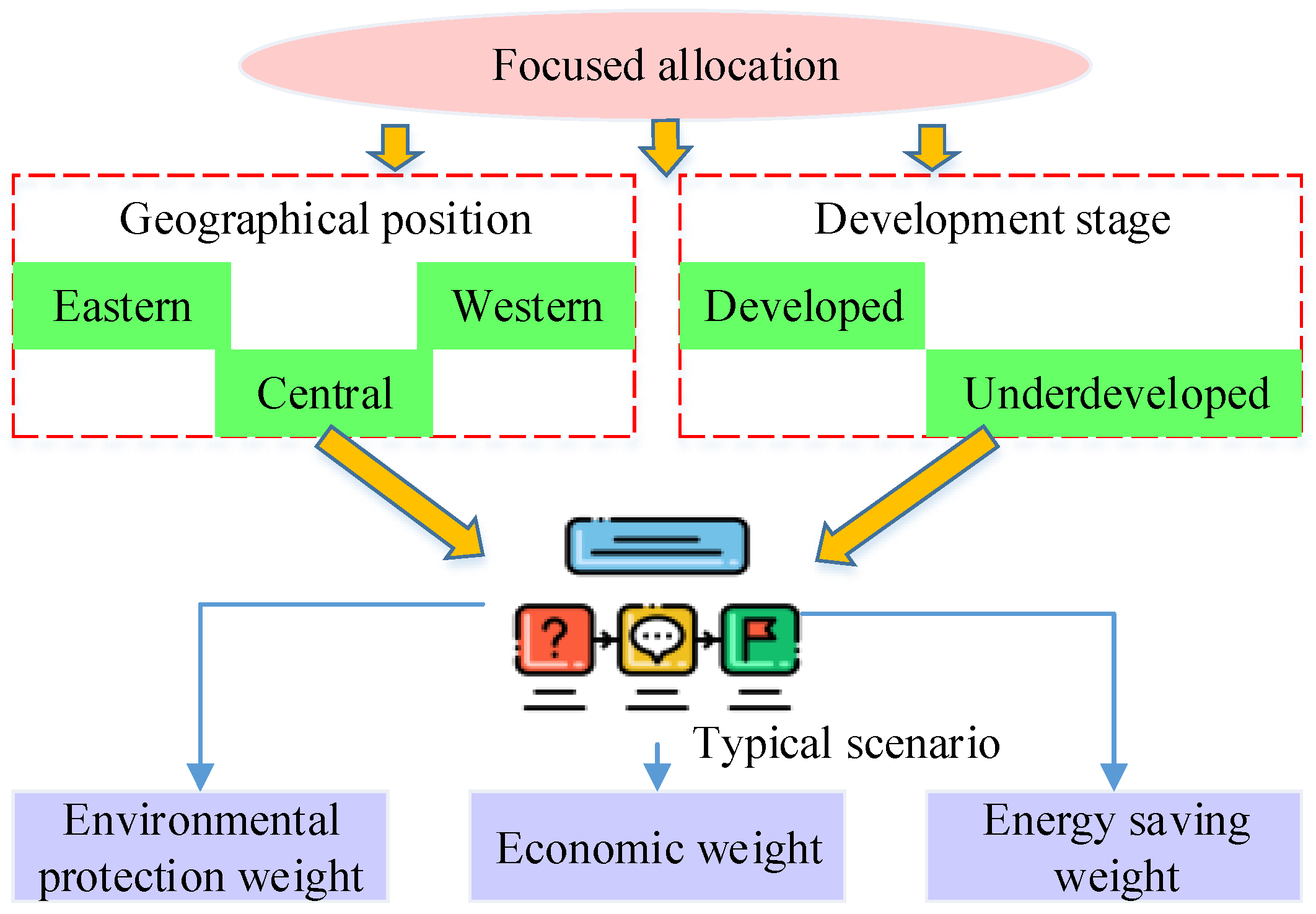
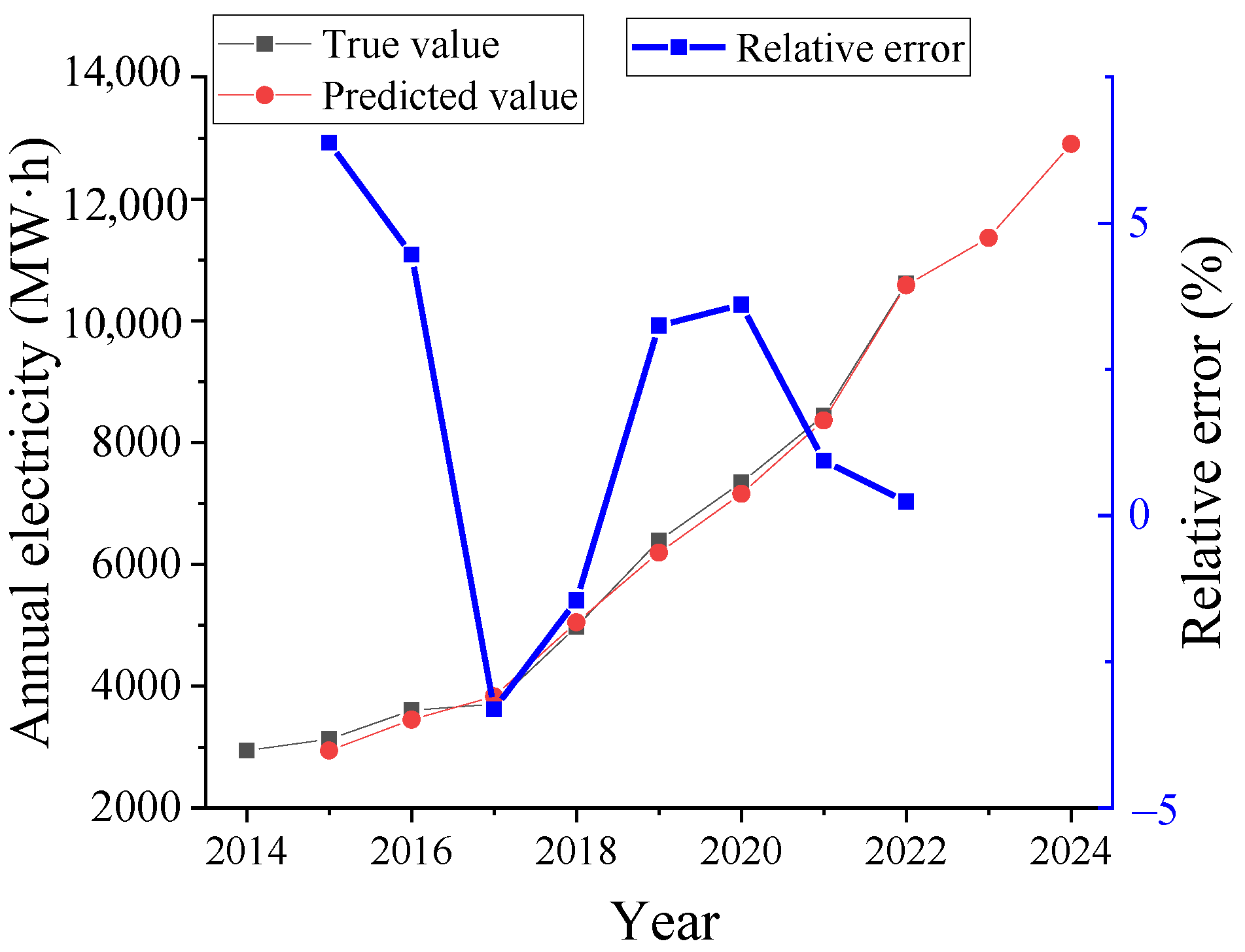
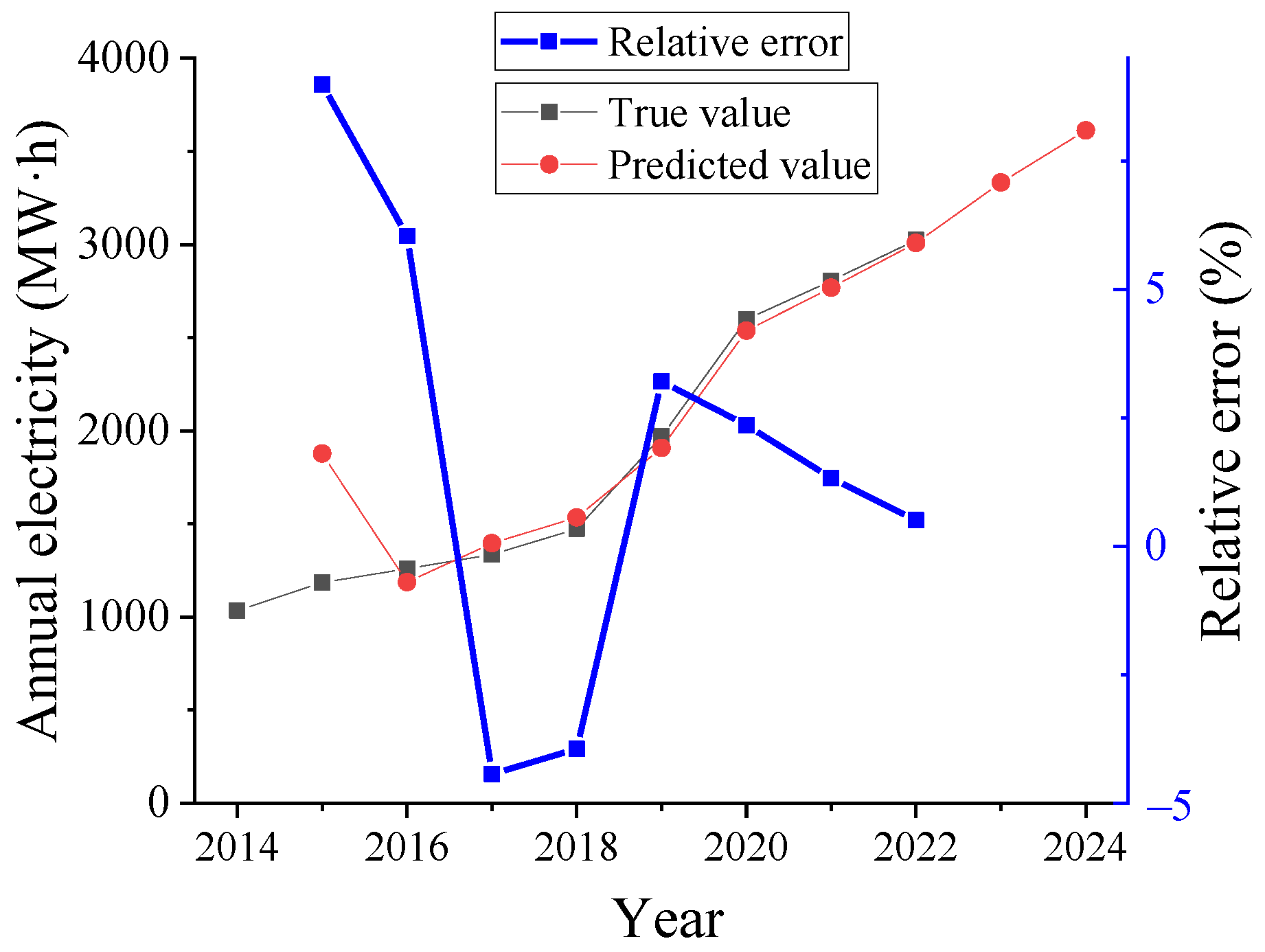
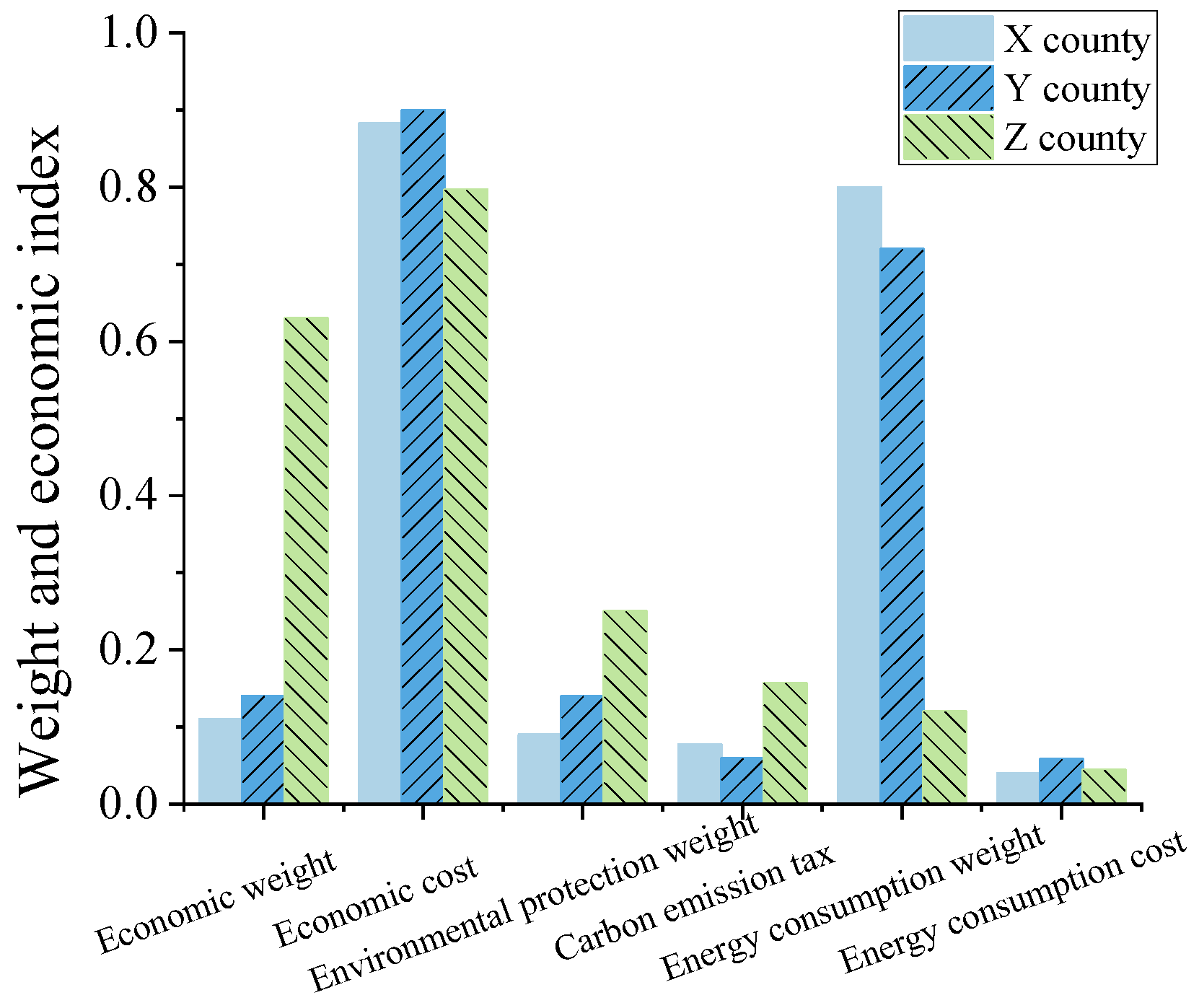
| Classification Criteria | Dimension | Development Characteristics | Energy-Resource Structure |
|---|---|---|---|
| Economic situation | Developed type | Agriculture, industry, and other sectors are developing rapidly, resulting in high energy consumption. | The energy is diversified, with electricity and natural gas as the primary sources. |
| Underdeveloped type | The energy infrastructure is relatively lagging behind. | They possess natural renewable energy sources with minimal energy loss. | |
| Geographical zone | Eastern region | Economic development is fast, and there is relatively low demand for heating. | Solar energy resources are moderate, with a focus on developing clean energy. |
| Central region | The power grid is relatively well-developed, with some areas having heating needs. | Abundant straw resources drive the centralized utilization of biomass. | |
| Western region | The northwest region experiences cold winters, while the southwest region has a mild climate. | Solar, wind, and other renewable energy sources are clean and abundant. |
| Basic Parameters | Numerical Values | |
|---|---|---|
| Coal-fired unit capacity (MW) | X County | 330 |
| Y County | 660 | |
| Biomass supply quantity (t/month) | X County | 3500 |
| Y County | 5000 | |
| Raw material recycling price (yuan/t) | Standard coal | 530 |
| Biomass | 300 | |
| Pollutant gas emission coefficient (kg/(kW·h)) | CO2 | 52.160 |
| NOX | 2.398 | |
| SO2 | 5.397 | |
| Energy System Planning | Numerical Values | |
|---|---|---|
| Estimated annual power generation | Solar photovoltaic | 180,000 megawatt hours |
| wind power generation | 120,000 megawatt hours | |
| Economic analysis | Investment cost | The total investment is about 300 million yuan, with a solar photovoltaic investment of 180 million yuan; Wind power investment: 120 million yuan |
| Payback period | 8 years | |
| Environmental benefits | Reducing CO2 emissions | Expected to reduce carbon emissions by approximately 260,000 tons annually |
| Other pollutants | Compared to coal-fired power generation, and emissions are reduced by approximately 3000 tons | |
| Energy Utilization Plan | Economic Benefits (10,000 Yuan/Year) | Environmental Benefits (Emission Reduction/Year) |
|---|---|---|
| Solar photovoltaic | 500 | 1000 |
| Wind power generation | 450 | 900 |
| Biomass coal combined utilization | 600 | 1200 |
Disclaimer/Publisher’s Note: The statements, opinions and data contained in all publications are solely those of the individual author(s) and contributor(s) and not of MDPI and/or the editor(s). MDPI and/or the editor(s) disclaim responsibility for any injury to people or property resulting from any ideas, methods, instructions or products referred to in the content. |
© 2024 by the authors. Licensee MDPI, Basel, Switzerland. This article is an open access article distributed under the terms and conditions of the Creative Commons Attribution (CC BY) license (https://creativecommons.org/licenses/by/4.0/).
Share and Cite
Peng, X.; Guan, X.; Zeng, Y.; Zhang, J. Artificial Intelligence-Driven Multi-Energy Optimization: Promoting Green Transition of Rural Energy Planning and Sustainable Energy Economy. Sustainability 2024, 16, 4111. https://doi.org/10.3390/su16104111
Peng X, Guan X, Zeng Y, Zhang J. Artificial Intelligence-Driven Multi-Energy Optimization: Promoting Green Transition of Rural Energy Planning and Sustainable Energy Economy. Sustainability. 2024; 16(10):4111. https://doi.org/10.3390/su16104111
Chicago/Turabian StylePeng, Xiaoyan, Xin Guan, Yanzhao Zeng, and Jiali Zhang. 2024. "Artificial Intelligence-Driven Multi-Energy Optimization: Promoting Green Transition of Rural Energy Planning and Sustainable Energy Economy" Sustainability 16, no. 10: 4111. https://doi.org/10.3390/su16104111
APA StylePeng, X., Guan, X., Zeng, Y., & Zhang, J. (2024). Artificial Intelligence-Driven Multi-Energy Optimization: Promoting Green Transition of Rural Energy Planning and Sustainable Energy Economy. Sustainability, 16(10), 4111. https://doi.org/10.3390/su16104111






